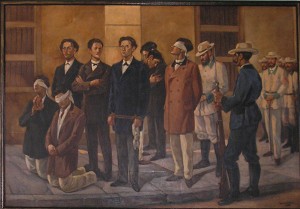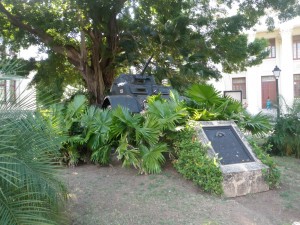Universidad de La Habana
May 3, 2012 by admin
During our second stay in Havana I made a trip to the University of Havana with a few other students from the group to conduct interviews with students there about our research topics. It was the first time that I had entered the campus, though we had passed its towering staircase with the Alma Mater statue at the top numerous times on the bus. It was also the first time that I ever considered the idea of a university, maybe similar to one in the United States existing in Cuba. This was a place that I felt I could directly connect with and relate to (they even had a chalkboard celebrating Pi Day!). Immediately I wanted to know more about the University and wished that I had ventured onto the campus earlier in the trip. When I got home I began exploring the University’s website (http://www.uh.cu/) and learned quite a bit about it.
The University of Havana began in 1798 as the Real y Pontificia Universidad de San Gerónimo de La Habana (the Royal and Pontificial University of Saint Geronimo of Havana). It was located in the convent of San Juan de Letrán and was largely a religious institution. From the beginning there were four areas of study: art and philosophy, theology, canon law, law and medicine. As the University continued to grow it became secular, changing its name to the Real y Literaria Universidad de La Havana (Royal and Literary University of Havana). The reformed university sought to expand the study of sciences and added case law, medicine, surgery, and farmacy to its list of deparments.
A particularly significant event occurred during this period of the University’s history, on November 27th, 1871. On that day eight medical students were assasinated for defacing the gravestone of a Spanish journalist, along with several other accusations of taking action against the Spanish colonial rule. These students (age 16-21) had been arrested only two days earlier from their classrooms by the Spanish Governor of Havana himself. The University website condemns their case, stating that it was based in false accusations and testimonies. Today Cubans still take to the streets of Havana on Novermber 27th, honoring the students as martyrs of the anti-imperial cause and calling for justice.
The University entered its third stage after Spanish rule of the island ended and the authority over it passed to Cubans. It was renamed the Universidad de La Habana, the name it holds to this day. Because of the deteriorating building of the convent where it was still located, the campus moved to its current position on a hill in the Vedado area of Havana. It remained that way until Fulgencio Batista closed its doors in 1956, but it was reopened three years later with the triumph of the Revolution in 1959. Since then the University of Havana has grown with the ideals of the Revolution, becoming only more integral with the restructuring and stregthening of the Cuban education system.
The University’s mission statement is as follows (in spanish):
Su misión es garantizar la formación integral y continua de profesionales altamente calificados, con capacidad de liderazgo científico y político al servicio de la sociedad y comprometidos con la Revolución, el Socialismo y el desarrollo sostenible del país. Cuenta para ello con el liderazgo que le confieren casi tres siglos de creación e impacto en la formación de la nación cubana y un reconocido prestigio nacional e internacional en las ciencias naturales, exactas, económicas, sociales y humanísticas.
It is clear from the mission statement that the University of Havana sees itself as playing and having played a central role in the development of Cuba as an independant nation. It is training its students to become competitive on the global scale and in many ways it is succeeding. It would be extremely interesting to study abroad at this university or even to establish connections between the University of Havana and Vassar. The educational environment is something so universal that could potentially stregthen ties between Americans and Cubans despite their governments’ differences. I would hope that in the future these ties can be better established.
Some fun facts:
- The University of Havana currently hosts over 60,000 students at undergraduate and graduate levels who study in 17 departments.
- There are 88 stairs leading up to the campus from the Calle San Lázaro.
- The first woman, Mercedes Riba, graduated in 1885.
- The campus has two museums: the Museo de Historia Nacional and the Museo Antropológico Montané.
- There is a tank that was captured by Castro’s rebels in 1958 located in front of the library.
Sources:
http://www.lonelyplanet.com/cuba/havana/sights/university/universidad-habana
http://www.uh.cu/historia
http://www.cubagenweb.org/mil/grande/students.htm
http://www.granma.cu/ingles/cuba-i/1dic-Student%20tribute.html
Leave a Reply
You must be logged in to post a comment.



